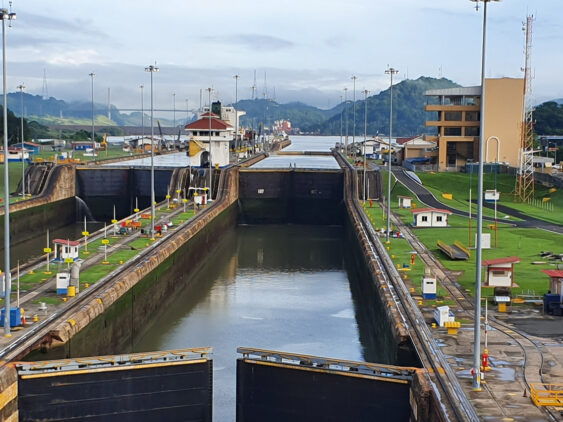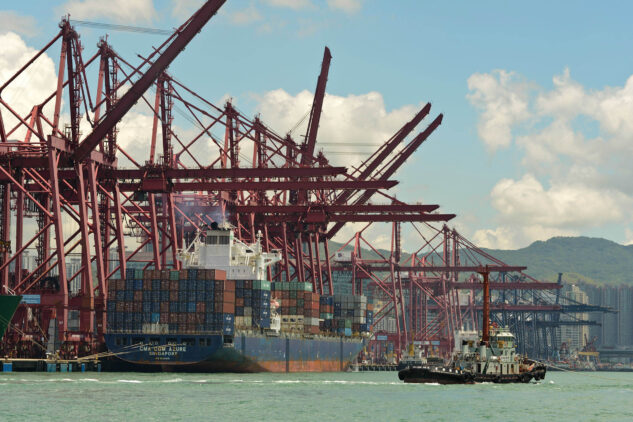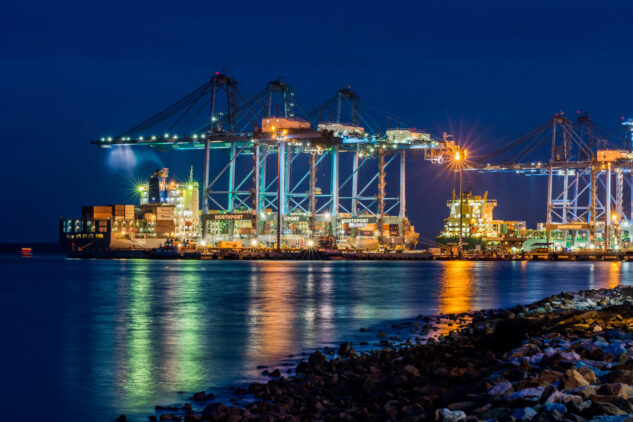Red Sea attacks, Panama Canal drought: The impact on international shipping
Global trade seemed to have arrived in calmer waters. But after riding a storm of uncertainty, cost increases and delays over the last six months, the closure of the Port of Baltimore caused by the collapse of the Francis Scott Key Bridge has shone a new spotlight on the sensitivity of logistics to maritime incidents.
While the impacts of the Dali’s recent bridge collision aren’t likely to be severe on a global scale, this incident is the latest in a sequence: ships diverting to avoid Houthi attacks in the Red Sea, and drought in the Panama Canal causing stringent limits on the amount of traffic which can pass across Lake Gatun.
All of this has a bearing on how much it costs and how long it takes to move overseas – especially when it comes to moving possessions to a new home abroad.
So as the USA rallies to resolve a new shipping crisis on its shore, what is the state of play with some of the other major issues which are adding complexity, delays and cost to moving goods around the world? And what should you do as you prepare to relocate and ship your possessions around the world?
Drought in the Panama Canal
The Panama Canal is an 82km artificial waterway in Panama, central America, which links the Pacific Ocean and the Atlantic Ocean.
An engineering marvel, ships carrying $270bn of cargo every year, pass across it via Gatun – a man-made lake 26 meters above sea level – which has locks at either end. At one end, ships are raised from the ocean onto the lake and at the other, they are lowered. A single ship passing through the canal and its locks uses an average of 52 million gallons of freshwater.
But the canal’s water levels are at their second lowest in 110 years of operation. Rain has been in short supply in recent times, meaning the lake has not been replenished as much as it normally would.
To save on water, the Panama Canal Authority (PCA) has limited the number of vessels which can pass along the canal each day from 36 to 24. Ships using the canal are also being asked to carry less cargo. These restrictions have seen trade volumes through the canal plummet by 49 per cent.

The overall impacts of these shipping incidents has been an increase in cost and time-in-transit for goods being shipped between continents. But challenges should be easing as rainfall arrives in Panama and as vessels bed into revised routes around Africa. This includes costs coming down and shipping times stabilizing.
Given five per cent of all maritime trade, and 40 per cent of US container traffic uses the canal, there has been a not-insignificant impact on transit times and costs for ships that normally use the east-west shortcut.
This has increased transit times and costs for shippers, although container ships and their cargo-owners have been cushioned from the worst of the impacts by being afforded priority to pass through the canal over other ship categories.
Many major lines, including MSC, CMA CGM and Hapag Lloyd have introduced surcharges for services operating through the canal, while Maersk has opted to shift some of its cargo onto rail services across Panama.
In March, the PCA was able to increase daily crossings to 27 – and it hopes that the return of the rainy season in May might facilitate a return to 36 crossings per day.
But in recent analysis, S&P Global warned that global supply chains could start to feel the effect in the coming months. Road and rail alternatives across Panama are seeing increased demand, particularly as security concerns in the Suez Canal persist.
An article by the BBC explores the measures that the PCA is taking to futureproof the canal as levels of rainfall continue to decrease. This includes water conservation.
Anyone moving goods between the east coast of the Americas and Asia or Oceania, are urged to be watchful of the situation, factor the potential for delays into planning, and speak to us about alternative routes or options.

Red sea remains a no-go zone
Throughout the first quarter of 2024, a new normal has been established after ships started to re-route around the Cape of Good Hope in southern Africa.
In December and January, most of the world’s major shipping lines took the decision to avoid the Red Sea and Suez Canal indefinitely, after Houthis attacked vessels using the critical sea-trade shortcut.
As lines announced their intentions to divert vessels, a journey which is around 3,500 nautical miles longer and takes an extra 10 days on average, shipping rates increased notably.
But that increase has since stabilized. Schedules, which were hugely disrupted initially, have also settled into a new normal with ports having adapted and cleared the backlogs of cargo.
This does mean, however, that shipping goods is more expensive, takes longer than it did this time last year – particularly for anyone shipping goods between the USA or Europe, and Asia – and is more carbon intensive.
Drewry’s March 28 World Container Index showed that the average cost of a 40-foot container was down to $2,929, from a high of $3,964 at the end of January. At their lowest in 2023, prices were at $1,342.
Attempts to stifle the Houthi attacks are having mixed results. Operation Prosperity Guardian – a US-led military consortium – and Operation Aspides – an EU maritime security operation – means there is now a significant naval military presence in the region. Warships are successfully repelling attacks, but aren’t yet deterring them. Since November, Houthis have launched attacks on more than 40 ships.
Maersk, the world’s second largest shipping line, said in a statement last month that it welcomed these developments to increase safety in the region, but it still believes sailing via the Cape of Good Hope to be “the most reasonable solution at the moment and the one that currently allows the best supply chain stability”. It added: “We remain hopeful that resuming sailing through the Red Sea will become possible in the near future.”
In a recent Bloomberg interview, Rolf Habben Jansen, the CEO of Hapag Lloyd – the world’s fifth largest container shipping line – said that the Red Sea diversions are likely to last at least few more months, with many predicting it to be longer. He added that spot container rates are also starting to come down.
We have been reaching out and talking to those impacted, to explore alternative routings, modes and services and ensure timely delivery of goods to destination.
Baltimore bridge collapse: a new challenge
On Tuesday, March 26, container ship Dali lost power, striking Baltimore’s 1.6-mile Francis Scott Key Bridge. The catastrophic impact caused the span to break and collapse into the water.
Six people working on the bridge at the time sadly lost their lives in the incident.
The ship will remain where it is, while the debris is salvaged from the river. During this time, access to the Port of Baltimore is limited. Two alternative channels have been opened, enabling some vessels currently stuck in the port to depart.
While the port is a very busy one, it largely handles vehicles and agricultural products. So while there may be some delays in the region, it’s unlikely that the closure of the port will have a far-reaching impact on global trade.
Shipping lines have announced diversions away from Baltimore, which is likely to cause short term congestion at other US ports on the east coast.
Quoting Chris Rogers, head of supply chain research at S&P Global Market Intelligence, The Loadstar reports: “Container lines are rerouting their services, including Maersk and MSC, which accounted for 53% of imports to Baltimore and are also major users of Philadelphia, Norfolk and Newark. While the peak season from July onward may prove more challenging, seasonal goods only represented 6% of Baltimore’s imports.”

Advice and how we can help
As we continue to see supply chain volatility, driven by maritime incidents, we are advising our customers in the coming weeks or months to:
· Bake additional lead time into plans as far as possible.
· Budget for increased transport costs
As always, feel free to contact your Move Manager, and we can work through the challenges that this situation is presenting together.